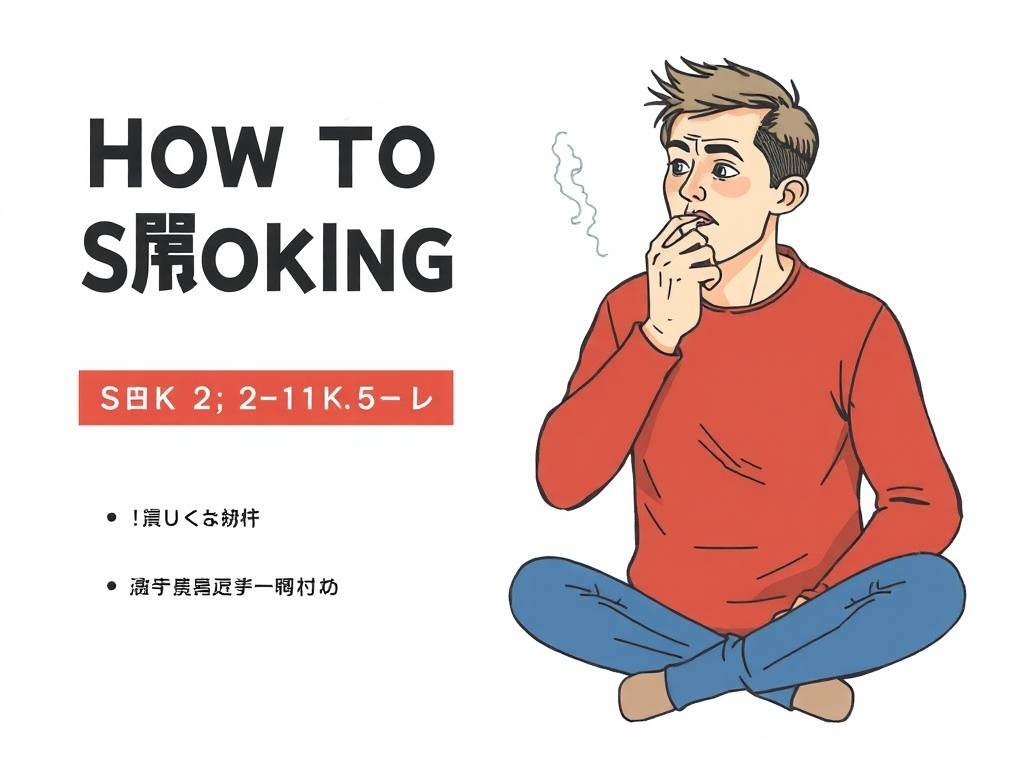How to Quit Smoking: A Step-by-Step Guide for Beginners
Quitting smoking is a life-changing decision, but for beginners, the process can feel overwhelming. Where do you start? How do you handle sudden cravings? What if you slip up? The good news is that breaking the habit doesn’t require perfection—it just needs a clear, step-by-step plan tailored to your needs. This guide is designed specifically for beginners, breaking down the 戒烟 journey into manageable steps, from setting your intention to staying smoke-free long-term. By following these steps, you’ll build confidence, reduce stress, and increase your chances of success.
Step 1: Choose Your "Quit Date" (And Stick to It)
The first and most important step is picking a specific quit date. This isn’t just a random day on the calendar—it’s a commitment to yourself, a clear line between your smoking past and smoke-free future. Choose a date that’s 1–2 weeks away: enough time to prepare, but not so far that you lose motivation. Avoid dates that are likely to be stressful (like a big work deadline or family event) or tied to smoking triggers (like a holiday party where alcohol will be served).
Once you’ve chosen your date, write it down everywhere: your phone lock screen, calendar, fridge, and even a sticky note on your laptop. Tell your friends, family, and coworkers about it too—accountability will keep you honest. In the days leading up to your quit date, start small: if you usually smoke 10 cigarettes a day, cut down to 8, then 6. This gradual reduction eases your body into lower nicotine levels, making withdrawal symptoms milder when the big day arrives. Remember: your quit date is non-negotiable. Even if you’re having a bad day, stick to it—procrastinating will only make it harder.
Step 2: Identify Your Smoking Triggers (And Plan to Avoid Them)
As a beginner, you might not realize how many parts of your day are tied to smoking. Do you smoke your first cigarette right after waking up? During your morning coffee? On your commute? After a meal? These are called "triggers"—people, places, activities, or emotions that make you crave a cigarette. The key to quitting is identifying these triggers before your quit date, so you can plan how to avoid or 应对 them.
Start by keeping a "smoking journal" for 3–5 days before quitting. Every time you smoke a cigarette, write down:
At the end of the week, review your journal. You’ll likely see patterns: maybe you smoke when you’re stressed at work, or when you’re watching TV at night. Once you’ve identified these triggers, make a plan to change them. For example:
If you smoke when you’re bored, keep a list of small activities handy (e.g., reading a chapter of a book, doing a 10-minute stretch, calling a friend).
Avoiding triggers doesn’t mean changing your entire life—it just means making small, intentional swaps that break the "smoking routine" your brain has learned.
Step 3: Gather Your Support System
Quitting smoking alone is hard, but with support, it’s much easier. As a beginner, you’ll need people who will cheer you on, help you through tough cravings, and hold you accountable. Your support system can include:
Other quitters: Join a beginner-friendly support group, either in-person (check with your local hospital or health clinic) or online (like the Reddit Quit Smoking community or the American Lung Association’s “Freedom From Smoking” program). Talking to people who are going through the same thing will make you feel less alone—they’ll understand what it’s like to wake up with a craving or feel irritable from withdrawal.
Healthcare provider: Schedule an appointment with your doctor or a smoking cessation counselor. They can answer your questions (e.g., “Is nicotine replacement therapy right for me?”), help you create a personalized plan, and even prescribe medication if needed. Studies show that beginners who work with a healthcare provider are twice as likely to quit successfully as those who go it alone.
Don’t be afraid to ask for help—quitting is a sign of strength, not weakness. Your support system will be there to lift you up when you stumble.
Step 4: Prepare for Withdrawal Symptoms (They’re Temporary!)
One of the biggest fears for beginners is nicotine withdrawal—and it’s true, withdrawal can be uncomfortable. But here’s the good news: withdrawal symptoms are temporary, and they peak within 1–3 days of quitting, then start to fade. Knowing what to expect will help you stay calm and avoid giving up.
Common withdrawal symptoms include:
To prepare for withdrawal, stock up on tools to ease these symptoms:
For cravings: Keep sugar-free gum, hard candies, or carrot sticks handy. Sipping water or taking 5 deep breaths (inhale for 4 seconds, hold for 2, exhale for 6) can also calm the urge.
For physical symptoms: Drink plenty of water to ease headaches, take short naps if you’re tired, and keep healthy snacks (like nuts, fruit, or yogurt) on hand to curb hunger.
Remember: every symptom you feel is a sign that your body is healing. Within 20 minutes of quitting, your heart rate drops. Within 12 hours, the carbon monoxide in your blood returns to normal. Within a week, your sense of taste and smell will improve. These small wins will make withdrawal worth it.
Step 5: Choose Tools to Help Manage Cravings (Nicotine Replacement or Not?)
As a beginner, you might wonder if you need tools like nicotine replacement therapy (NRT) to quit. NRT—products like patches, gum, lozenges, inhalers, or nasal sprays—delivers a small, controlled dose of nicotine to your body, reducing cravings and withdrawal symptoms. It’s safe for most people (when used as directed) and can double your chances of success.
If you decide to use NRT, talk to your doctor first. They’ll help you choose the right product:
You don’t have to use NRT, though. Some beginners prefer to quit “cold turkey” (without any nicotine replacement). If you choose this route, focus on the tools you prepared for withdrawal: deep breathing, healthy snacks, exercise, and support from your network. The key is to pick what feels right for you—there’s no “one-size-fits-all” approach.
Step 6: Take It One Day at a Time (Celebrate Small Wins)
Quitting smoking is a journey, not a destination—and for beginners, it’s easy to get overwhelmed by thinking about “never smoking again.” Instead, focus on one day at a time. Ask yourself: “Can I go 24 hours without smoking?” Most of the time, the answer is yes.
At the end of each smoke-free day, take a moment to celebrate. It doesn’t have to be a big celebration—maybe you treat yourself to a favorite snack, watch an episode of your favorite show, or write down how you feel in a journal. These small wins build confidence and keep you motivated.
After a week, celebrate bigger: maybe buy a new book, get a massage, or plan a fun outing with friends. Keep track of your progress (use an app like Quit Now! or a paper calendar) so you can see how far you’ve come. When you’re having a tough day, look back at your progress—you’ll be surprised by how much you’ve accomplished.
Step 7: Handle Slip-Ups (They Don’t Mean Failure)
Every beginner makes mistakes—and that’s okay. A slip-up (smoking one cigarette) doesn’t mean you’ve failed at quitting; it just means you’re human. The worst thing you can do is give up and say, “I’ll never quit, so I might as well keep smoking.” Instead, use the slip-up as a learning opportunity.
Ask yourself:
What triggered the slip-up? (e.g., I was stressed at work, I was with a friend who smokes, I drank alcohol.)
What could I do differently next time? (e.g., I’ll take a walk when I’m stressed, I’ll avoid that friend’s house for a while, I’ll skip alcohol until I’m more confident.)
Then, get back on track immediately. Don’t wait until “tomorrow” or “next week”—start being smoke-free again right away. Remember: even the most successful ex-smokers had slip-ups. What matters is how you respond to them.
Step 8: Stay Smoke-Free Long-Term (Build a New Routine)
After the first month, the hardest part is over—but staying smoke-free long-term takes effort. As a beginner, you’ll need to build a new, smoke-free routine that replaces your old smoking habits. Here are some tips to help:
Keep avoiding triggers: Even after a few months, triggers can still cause cravings. If you used to smoke after meals, keep taking that post-meal walk. If you used to smoke while drinking coffee, keep sipping your coffee while reading a book.
Stay active: Regular exercise (like 30 minutes of walking, cycling, or yoga 5 days a week) keeps your mind and body healthy, reduces stress, and curbs cravings. It also helps prevent weight gain, a common concern for beginners.
Reward yourself: Every month, celebrate your smoke-free milestone with a big reward—maybe a weekend trip, a new hobby, or a nice dinner. Use the money you’re saving from not smoking (the average smoker spends \(1,000–\)3,000 a year on cigarettes!) to treat yourself.
Check in with your support system: Even if you’re feeling confident, keep talking to your friends, family, or support group. They’ll help you stay accountable and celebrate your long-term success.
Final Thoughts for Beginners
Quitting smoking is hard, but as a beginner, you have something powerful on your side: motivation. You’ve already taken the hardest step—deciding to quit. By following this step-by-step guide, you’ll turn that motivation into action, and action into a smoke-free life.
Remember: every day you don’t smoke is a win. Every craving you overcome is a sign of strength. Every slip-up is a chance to learn. You’re not just quitting smoking—you’re giving yourself more energy, better health, more money, and more time with the people you love.
You can do this. Take it one step at a time, lean on your support system, and be kind to yourself. Before you know it, you’ll be an ex-smoker—and you’ll wonder why you didn’t quit sooner.















